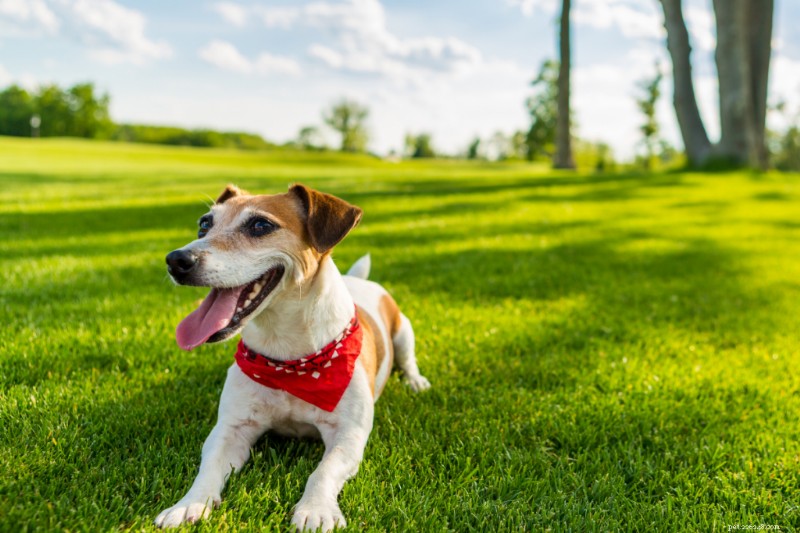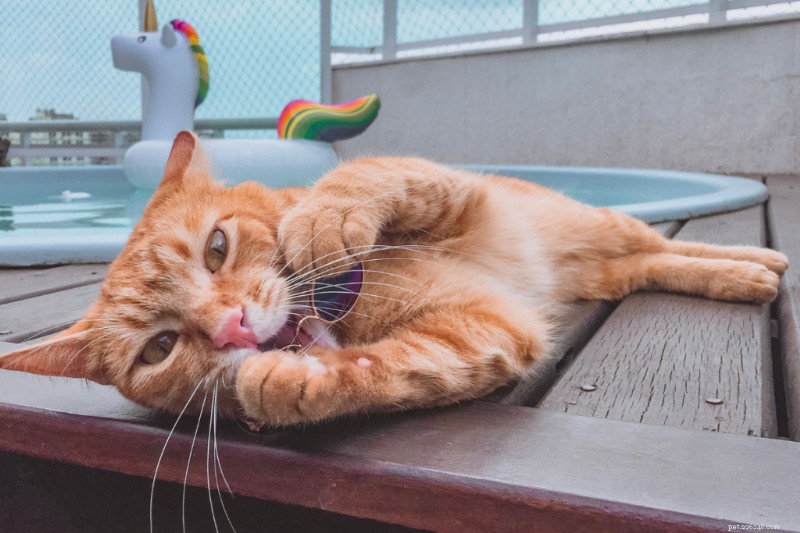10 dicas de segurança para animais de estimação no verão
Os pais de animais de estimação sabem que, durante o calor dos meses de verão, é crucial prestar atenção aos seus animais de estimação. As temperaturas quentes e pegajosas que ocorrem durante os "Dias de verão de cachorro" também aumentam o risco de exaustão pelo calor e insolação, portanto, enfatizar a segurança do animal de estimação no verão é fundamental.
Os cães só podem se refrescar ofegando, o que significa que colocá-los na frente de um ventilador não terá o mesmo efeito de resfriamento neles que terá em você. Os gatos podem fornecer um efeito de transpiração semelhante ao humano lambendo a pelagem, mas um quarto fresco, sombreado ou com ar condicionado é a melhor opção para manter seus animais de estimação seguros e felizes.
Se você está procurando uma solução para aproveitar ao máximo o verão e priorizar a segurança dos animais de estimação, confira essas dicas de segurança para animais de estimação no verão.

10 dicas para segurança de animais de estimação no verão
1. Nunca deixe um animal de estimação em um carro
Se você está planejando sair e fazer recados, deixe seu animal de estimação com segurança em casa. Durante os meses de verão, seu carro aquecerá rapidamente a temperaturas insuportáveis, mesmo com uma janela rachada. Isso pode levar a sérias complicações de saúde, incluindo perda de consciência, falência de órgãos, inchaço do cérebro e perda de vida. Mesmo que pareça “frio” ao ar livre, as temperaturas em seu veículo ainda não são seguras.
Para aqueles que planejam viajar com um animal de estimação durante os meses de verão, tenha um plano para manter seu animal de estimação seguro se precisar fazer uma pausa no banheiro ao longo do caminho.
Se você estiver viajando com outra pessoa, revezem-se enquanto uma pessoa permanece no veículo com o ar condicionado ligado para o seu animal de estimação.
Se você estiver sozinho, você precisa encontrar uma maneira de levar seu animal de estimação com você. Uma opção é parar em pet shops e pet friendly shops. Outra é ter uma transportadora para animais de estimação ou um carrinho de bebê para levar seu animal de estimação para as paradas de descanso na estrada.
Se você tropeçar em um animal de estimação em um carro quente, existem algumas maneiras legais de ajudar.
Além dos perigos dos carros quentes, há também o risco de alguém invadir seu carro e roubar seu animal de estimação enquanto ele ou ela estiver desacompanhado.
2. Evite festivais, feiras, mercados públicos e outros eventos públicos
Por mais tentador que seja levar seu cão ou gato para os festivais e eventos locais de verão, a melhor escolha que você pode fazer para a segurança do seu animal de estimação é deixá-los em casa. Entre os ruídos, os cheiros desconhecidos, as multidões e as calçadas ou calçadas quentes, você estará fazendo mais mal do que bem ao seu animal de estimação ao trazê-lo.
Se você quiser mostrar seu animal de estimação para seus amigos, fique com o smartphone cheio de fotos de animais de estimação que a maioria dos pais de animais de estimação tem à mão.
3. Considere protetor solar e queimaduras solares
Se você vai passar tempo ao ar livre com seu animal de estimação, considere comprar protetor solar para mantê-los protegidos dos perigosos raios UV do sol. Cães e gatos de cor clara ou aqueles com pelagem incrivelmente curta são propensos a queimaduras solares, assim como seus humanos. Eles também correm o risco de desenvolver câncer de pele se você não tomar precauções para mantê-los seguros.
Peça conselhos ao seu veterinário sobre protetores solares não tóxicos e seguros para animais de estimação.

4. Procure sombra ao ar livre
Além de usar protetor solar, você pode proteger seu animal de estimação do sol encontrando sombra o mais rápido possível. Quando estiver caminhando, mude para o lado sombreado da calçada.
If you are going to be spending time outdoors somewhere where there is no shade readily available, consider bringing along a beach umbrella, tent, awning, or sun shelter to create your own shade.
5. Limit Physical Activity on Hot Days
Do you have a high-energy dog or cat that enjoys playing outdoors? If you know that your dog will chase a ball or a frisbee until they drop or you cat will walk or hike for hours, this is a tip that you should consider!
Dehydration and heatstroke are real possibilities during a hot, humid summer day, even in the safety of your own backyard. Limit the high-energy activities to the cooler morning or evening hours. Pets that are brachycephalic, those with flat-shaped faces such as Pugs, Pekingese, or Persian cats, have a harder time cooling themselves by panting. Additional precautions need to be taken to keep these breeds cool in the hot summer months.
6. Know the Warning Signs of Dehydration
Make sure that your pet’s water dish is always full of water. Don’t let it get to the point where the dish is empty and you fill it, leading to your pet overindulging. This can lead to bloat and an emergency trip to see the vet. Warning signs of dehydration in pets include dry and pale gums, excessive drooling, loss of skin elasticity, and acting lethargic.
If you take your pet for a walk, visit the beach, or head out on the hiking trails, make sure you bring a bowl and fresh water. Make frequent stops to give your pet a sip or two, preventing them from drinking too much at any one time.
7. Be Cautious of Pesticides
During the warmer months, you may find yourself out and enjoying the beautiful weather by taking more walks. Use caution when you’re walking your pet in unfamiliar territory. There are some communities that still use non-pet-friendly pesticides and many of those chemicals have a sweet flavor that is enticing to your pet.
If your pet walks in pesticide-treated grass then licks their fur or feet, they could be ingesting poisons. It’s always best to know where you’re walking your pet before you set out and keep an eye out for small lawn flags signaling pesticide application during your journey.
8. Stick to the Cool Walking Hours
Another point to consider when planning your walks is the time that you are heading out. During the summer months, surfaces such as pavement, cement, and asphalt can become dangerously hot. These surfaces absorb and retain the summer heat, causing the temperatures to rise far beyond that of the surrounding air. Walking on these hot surfaces could lead to heat blisters and burns on your pet’s delicate paw pads. Instead, plan your walks for the early mornings and cooler evenings.
If you do need to head out with your pet during the warmer hours of the day, take precautions to protect their paws. If possible, carry your pet when navigating hot surfaces. Another option would be to outfit your pet with breathable, summer-friendly paw booties.

9. Avoid Shaving Long Fur
If you have a dog or cat with long fur or a double coat, you may be worried that all the extra fur is going to leave them feeling overheated. Even though it may be tempting, you shouldn’t give in to the urge to shave your pet’s long fur off for the summer. Your pet’s hair acts as a protective layer.
Instead, brush them regularly to remove excess fur from their natural seasonal shedding and focus on giving them access to a cool space to relax.
10. Protect Against Fleas, Ticks and Other Parasites
During the summer months, your pets may encounter unwanted parasites while they are out and about. To keep your pet safe from unwanted hitchhikers, you should consider using the appropriate preventative medications. Contact your vet to discuss the available options and which would be best for your pet’s needs.
Even with the necessary preventatives, your pet may encounter a tick. To reduce your pet’s chances of dealing with complications such as Lyme disease, take the time to do a full check of your pet’s body for ticks after spending time outdoors. Focus largely on the vulnerable areas including the head, ears, eyelids, under the collar, between the toes, groin, armpits, and tail. Learn how to remove a tick safely and consider carrying a tick key with you.
What do you do to keep your pets cool, happy, and healthy during the summer months? Feel free to share your summer pet safety tips in the comments!
- Dicas para cães
- Dicas de segurança para animais de estimação no Dia de Ação de Graças
- Dicas de segurança para evacuação de animais de estimação
- Dicas de segurança obrigatórias para o 4 de julho
- Dicas de segurança contra picada de cobra para um verão seguro com seu animal de estimação
- Dicas de segurança para animais de estimação no Halloween
- DICAS DE EMERGÊNCIA PARA MANTER SEU PET SEGURO

